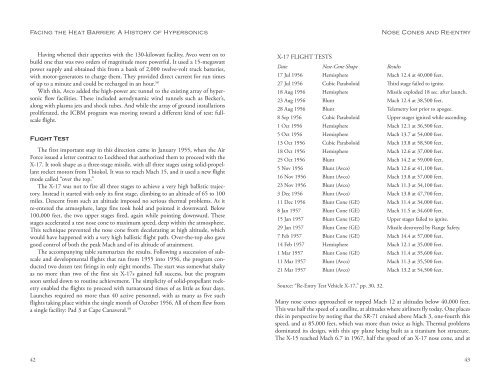Facing the Heat Barrier - NASA's History Office
Facing the Heat Barrier - NASA's History Office
Facing the Heat Barrier - NASA's History Office
Create successful ePaper yourself
Turn your PDF publications into a flip-book with our unique Google optimized e-Paper software.
<strong>Facing</strong> <strong>the</strong> <strong>Heat</strong> <strong>Barrier</strong>: A <strong>History</strong> of Hypersonics<br />
Having whetted <strong>the</strong>ir appetites with <strong>the</strong> 130-kilowatt facility, Avco went on to<br />
build one that was two orders of magnitude more powerful. It used a 15-megawatt<br />
power supply and obtained this from a bank of 2,000 twelve-volt truck batteries,<br />
with motor-generators to charge <strong>the</strong>m. They provided direct current for run times<br />
of up to a minute and could be recharged in an hour. 58<br />
With this, Avco added <strong>the</strong> high-power arc tunnel to <strong>the</strong> existing array of hypersonic<br />
flow facilities. These included aerodynamic wind tunnels such as Becker’s,<br />
along with plasma jets and shock tubes. And while <strong>the</strong> array of ground installations<br />
proliferated, <strong>the</strong> ICBM program was moving toward a different kind of test: fullscale<br />
flight.<br />
Flight Test<br />
The first important step in this direction came in January 1955, when <strong>the</strong> Air<br />
Force issued a letter contract to Lockheed that authorized <strong>the</strong>m to proceed with <strong>the</strong><br />
X-17. It took shape as a three-stage missile, with all three stages using solid-propellant<br />
rocket motors from Thiokol. It was to reach Mach 15, and it used a new flight<br />
mode called “over <strong>the</strong> top.”<br />
The X-17 was not to fire all three stages to achieve a very high ballistic trajectory.<br />
Instead it started with only its first stage, climbing to an altitude of 65 to 100<br />
miles. Descent from such an altitude imposed no serious <strong>the</strong>rmal problems. As it<br />
re-entered <strong>the</strong> atmosphere, large fins took hold and pointed it downward. Below<br />
100,000 feet, <strong>the</strong> two upper stages fired, again while pointing downward. These<br />
stages accelerated a test nose cone to maximum speed, deep within <strong>the</strong> atmosphere.<br />
This technique prevented <strong>the</strong> nose cone from decelerating at high altitude, which<br />
would have happened with a very high ballistic flight path. Over-<strong>the</strong>-top also gave<br />
good control of both <strong>the</strong> peak Mach and of its altitude of attainment.<br />
The accompanying table summarizes <strong>the</strong> results. Following a succession of subscale<br />
and developmental flights that ran from 1955 into 1956, <strong>the</strong> program conducted<br />
two dozen test firings in only eight months. The start was somewhat shaky<br />
as no more than two of <strong>the</strong> first six X-17s gained full success, but <strong>the</strong> program<br />
soon settled down to routine achievement. The simplicity of solid-propellant rocketry<br />
enabled <strong>the</strong> flights to proceed with turnaround times of as little as four days.<br />
Launches required no more than 40 active personnel, with as many as five such<br />
flights taking place within <strong>the</strong> single month of October 1956. All of <strong>the</strong>m flew from<br />
a single facility: Pad 3 at Cape Canaveral. 59<br />
42<br />
X-17 FLIGHT TESTS<br />
Nose Cones and Re-entry<br />
Date Nose-Cone Shape Results<br />
17 Jul 1956 Hemisphere Mach 12.4 at 40,000 feet.<br />
27 Jul 1956 Cubic Paraboloid Third stage failed to ignite.<br />
18 Aug 1956 Hemisphere Missile exploded 18 sec. after launch.<br />
23 Aug 1956 Blunt Mach 12.4 at 38,500 feet.<br />
28 Aug 1956 Blunt Telemetry lost prior to apogee.<br />
8 Sep 1956 Cubic Paraboloid Upper stages ignited while ascending.<br />
1 Oct 1956 Hemisphere Mach 12.1 at 36,500 feet.<br />
5 Oct 1956 Hemisphere Mach 13.7 at 54,000 feet.<br />
13 Oct 1956 Cubic Paraboloid Mach 13.8 at 58,500 feet.<br />
18 Oct 1956 Hemisphere Mach 12.6 at 37,000 feet.<br />
25 Oct 1956 Blunt Mach 14.2 at 59,000 feet.<br />
5 Nov 1956 Blunt (Avco) Mach 12.6 at 41,100 feet.<br />
16 Nov 1956 Blunt (Avco) Mach 13.8 at 57,000 feet.<br />
23 Nov 1956 Blunt (Avco) Mach 11.3 at 34,100 feet.<br />
3 Dec 1956 Blunt (Avco) Mach 13.8 at 47,700 feet.<br />
11 Dec 1956 Blunt Cone (GE) Mach 11.4 at 34,000 feet.<br />
8 Jan 1957 Blunt Cone (GE) Mach 11.5 at 34,600 feet.<br />
15 Jan 1957 Blunt Cone (GE) Upper stages failed to ignite.<br />
29 Jan 1957 Blunt Cone (GE) Missile destroyed by Range Safety.<br />
7 Feb 1957 Blunt Cone (GE) Mach 14.4 at 57,000 feet.<br />
14 Feb 1957 Hemisphere Mach 12.1 at 35,000 feet.<br />
1 Mar 1957 Blunt Cone (GE) Mach 11.4 at 35,600 feet.<br />
11 Mar 1957 Blunt (Avco) Mach 11.3 at 35,500 feet.<br />
21 Mar 1957 Blunt (Avco) Mach 13.2 at 54,500 feet.<br />
Source: “Re-Entry Test Vehicle X-17,” pp. 30, 32.<br />
Many nose cones approached or topped Mach 12 at altitudes below 40,000 feet.<br />
This was half <strong>the</strong> speed of a satellite, at altitudes where airliners fly today. One places<br />
this in perspective by noting that <strong>the</strong> SR-71 cruised above Mach 3, one-fourth this<br />
speed, and at 85,000 feet, which was more than twice as high. Thermal problems<br />
dominated its design, with this spy plane being built as a titanium hot structure.<br />
The X-15 reached Mach 6.7 in 1967, half <strong>the</strong> speed of an X-17 nose cone, and at<br />
43
















